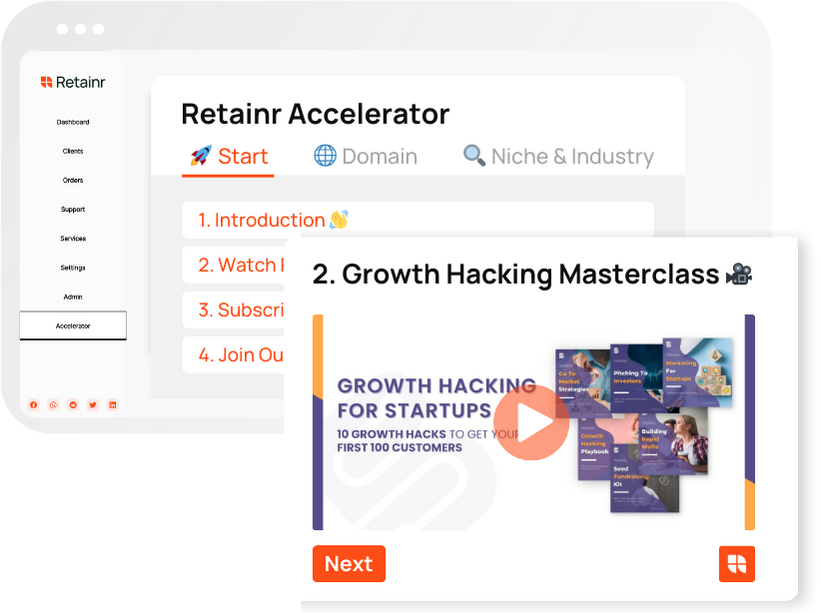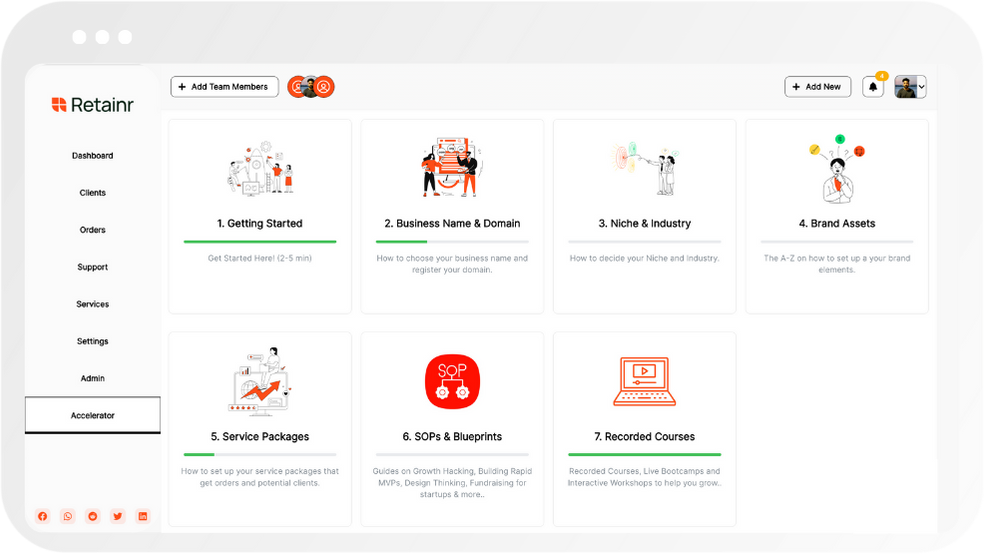
6 Steps to Scale Your E-Commerce Business Successfully
Build with Retainr
Sell your products and services, manage clients, orders, payments, automate your client onboarding and management with your own branded web application.
Get Started1. What are the six steps to scale an e-commerce business successfully?
Step 1: Understand Your Business
The first step to successfully scaling an e-commerce business is to have a profound understanding of the business. This includes the strengths, weaknesses, opportunities, and threats it faces. The SWOT analysis is a helpful tool for this. A clear understanding of the business leads to data-driven decisions that set the course for growth.
Step 2: Optimize Your Website
The second step is to improve your website for a smooth, user-friendly experience. This process may entail upgrading the load time, enhancing navigation, and ensuring mobile compatibility. After all, the website is your online store, and a well-optimized website plays a vital role in customer acquisition and retention. Upgrading the website to be SEO-friendly can boost organic reach and improve visibility on search engines.
- Improve website loading speed
- Enhance navigation
- Ensure mobile compatibility
- Upgrade SEO
Step 3: Leverage Technology
The third step is to make the most out of technology. This involves automation of processes that can be handled by systems and utilizing eCommerce platforms that offer high-quality and efficient tools for shipping, inventory management, customer service, and marketing.
| Processes to Automate | eCommerce Platforms |
|---|---|
| Shipping | Shopify, Magento |
| Inventory Management | WooCommerce, BigCommerce |
| Customer Service | Squarespace, Wix |
| Marketing | Amazon, eBay |
Step 4: Expand Your Market Reach
Once you have a robust system in place, the next step is to expand your market reach. This involves strategies to reach a wider, global audience. You can do this by using multi-channel selling, International SEO, and localized content.
Step 5: Foster Customer Loyalty
While attracting new customers is important, it's equally necessary to turn them into repeat customers. A customer retention program is an effective strategy to maintain and increase existing customers' loyalty. This can include loyalty programs, personalized communication, and excellent after-sales support.
Step 6: Continuous Monitoring and Improvement
The final step in scaling an e-commerce business successfully is continuous monitoring and improvement. This involves tracking key performance indicators (KPIs) regularly and making necessary adjustments based on the results. Continuous improvement keeps your business adaptable to changing market conditions and customer preferences.
2. How can I apply these six steps to my e-commerce business?
Understanding the Six Steps
The six steps to successfully scaling your e-commerce business include: (1) Goal setting and planning, (2) Streamlining operations, (3) Optimizing for SEO, (4) Enhancing customer experience, (5) Expanding marketing efforts, and (6) Analyzing and improving. To apply these steps to your e-commerce business, you'll need to understand each step thoroughly and be prepared to work systematically. Let's break down these steps further:
- Goal Setting and Planning: Identify your business's objectives both short term and long term. Is it to increase sales, grow your customer base or to expand into new markets?
- Streamlining Operations: This involves the integration of all necessary business systems - from inventory management to customer service and shipping.
- Optimizing for SEO: SEO is crucial in improving visibility and driving organic traffic. You must implement best SEO practices such as keyword optimization, regular audits and backlinking.
- Enhancing Customer Experience: This involves improving the usability of your website, the quality of your customer service, and your overall engagement approach.
- Expanding Marketing Efforts: Discover new marketing channels and strategies, including social media and email marketing, or optimizing existing one.
- Analyzing and Improving: Use analytic tools to track, measure and interpret data to make necessary improvements.
Applying the Steps to Your E-commerce Business
To apply these six steps to your e-commerce business, it might be helpful to create a table mapping your business's current status, objectives for each step, and a timeline for action.
| Steps | Current Status | Objectives | Action Timeline |
|---|---|---|---|
| 1. Goal Setting and Planning | --- | --- | --- |
| 2. Streamlining Operations | --- | --- | --- |
| 3. Optimizing for SEO | --- | --- | --- |
| 4. Enhancing Customer Experience | --- | --- | --- |
| 5. Expanding Marketing Efforts | --- | --- | --- |
| 6. Analyzing and Improving | --- | --- | --- |
Adjust and Update Your Business Plan Regularly
The final important step in applying these six steps to your e-commerce business is to constantly evaluate and adjust your plan as necessary. Your business plan should be dynamic, accounting for shifts in market trends, customer behavior, and business performance. By regularly reviewing these six steps and adjusting your objectives and strategies accordingly, you can ensure your e-commerce business scales successfully and sustainably.
3. Can you explain each step involved in scaling an e-commerce business successfully?
Step 1: Analyze Your Business
Understanding your business's strengths, weaknesses, opportunities, and threats (SWOT) is the first step towards scaling it. Here, you should focus on key areas such as:
- Current Sales
- Profit Margins
- Customer Acquisition Cost
- Customer Lifetime Value
These metrics will help in determining what aspects to scale and by how much. It's also important to benchmark your business against competitors and industry standards.
Step 2: Develop a Robust Scaling Strategy
Once you've analyzed your business, the next step is formulating a solid strategy for scaling. This should consist of both long-term and short-term plans that will guide your business decisions. Key elements of a good scaling strategy should be:
| Elements | Description |
|---|---|
| Goal Setting | Define clear, achievable objectives that align with your business growth aspirations |
| Resource Planning | Identify the kind of resources -- human and material -- that will be required to achieve the goals set |
| Market Analysis | Analyze and understand the market trends and customer behavior |
| Implementation Plan | Detail on how you’ll execute your strategies, complete with timelines and tasks. |
Step 3: Streamline Operations
The efficiency of your operations can either fuel or limit the rate of your eCommerce scaled growth. Enhance productivity by:
- Automating repetitive tasks and processes. This saves time and reduces the risk of errors.
- Optimizing your supply chain to ensure there's no delay from the time a purchase is made to when the product is delivered
- Integrating systems to ensure smooth flow of data and information
After streamlining, regularly review your operations to track their efficiency and identify areas that require improvement.
4. What are the common challenges faced while scaling an e-commerce business and how can they be overcome?
Common Challenges of Scaling an E-commerce Business
The very nature of an e-commerce business means scaling is not just conceivable but relatively straightforward, yet several obstacles can present themselves in the process. Ranging from issues with managing increased demand to infrastructure challenges, these problems can impede growth and ultimately affect your bottom line. The key challenges are:
- Inventory Management: Coordinating increased stock levels and satisfying customer orders efficiently can become a serious issue as your business grows.
- Logistics and Fulfilment: The need for faster processing and shipping of orders to improve customer satisfaction can lead to additional stress on your supply chain.
- Customer Service: With the increase of customers comes the challenge of maintaining high-quality customer service and dealing with a higher volume of inquiries and complaints.
- Infrastructure and Technology: A rapidly growing business requires the necessary infrastructure, both digital and physical, to handle its operations. This may involve upgrading software systems or acquiring new facilities for warehousing.
- Internationalization: If expanding globally, additional challenges such as dealing with multiple currencies, customs, taxes, legal issues, and varied consumer behaviours can surface.
Overcoming Scaling Challenges
These hurdles, while substantial, are not insurmountable if tackled strategically and proactively. Here are a few ways to overcome these challenges:
- Use of Inventory Management Software: This can help automate tracking of stock levels and provide real-time data improving efficiency and reliability.
- Establish Partnerships: Partnerships with logistic providers can help manage high demand and improve your supply chain operations.
- Scale Customer Service Operations: Consider outsourcing or technology implementations like AI chatbots to efficiently handle customer inquiries.
- Invest in Scalable Infrastructure: Choose software systems and physical facilities that can scale with your business, allowing for future growth without unnecessary bottlenecks.
- Consult with Experts: If expanding globally, seeking assistance from experts with knowledge in international commerce can help navigate potential pitfalls.
Comparison of Solutions
| Challenge | Solution |
|---|---|
| Inventory Management | Inventory Management Software |
| Logistics and Fulfilment | Partnership with Logistics Providers |
| Customer Service | Outsourcing or AI Implementation |
| Infrastructure and Technology | Scalable Infrastructure Investment |
| Internationalization | Consulting with Experts |
5. How important is customer service in scaling an e-commerce business successfully?
The Significance of Customer Service in Successfully Scaling an E-Commerce Business
One cannot downplay the critical role that customer service plays in scaling an e-commerce business successfully. A business's growth is tightly tied to its ability to maintain a satisfied and loyal customer base. Excellent customer service also creates an enviable reputation that attracts potential customers. Here's why customer service is essential:
- Boosts customer loyalty: A study by the White House Office of Consumer Affairs found that it's 6-7 times more costly to attract a new customer than to retain an existing one.
- Influences purchasing decisions: According to a survey by American Express, more than half (60%) of customers are willing to pay more for a better customer service experience.
- Aids in customer retention: Satisfied customers are likely to stay. Customer service plays an essential role in ensuring that customers experience satisfaction with every interaction.
Evaluating the Impact of Customer Service
Metrics can be used to measure the efficiency of your customer service and its impact on your e-commerce business. They help you gauge whether your customer service strategies are working or need adjustment. They also offer insight into customer preferences, behavior, and satisfaction levels.
| Metric | Description |
|---|---|
| Customer Satisfaction Score (CSAT) | This measures immediate customer satisfaction levels with your service. |
| Net Promoter Score (NPS) | NPS assesses the likelihood of your customers recommending the business to others. It's a good predictor of customer loyalty. |
| Customer Effort Score (CES) | This metric gauges the ease or difficulty of a customer's interaction with your business. |
Improving Customer Service for Business Growth
Businesses should invest time and resources into optimizing their customer service for growth. Here are several ways businesses can achieve customer service excellence:
- Invest in staff training: Ensure your customer service representatives have the necessary skills and knowledge to efficiently handle customer inquiries and complaints.
- Implement efficient systems: Use CRM systems and other customer service technology to manage and streamline customer service processes.
- Use customer feedback: Regularly solicit feedback from your customers, and use this data to improve your services and products.
By making customer service a top priority, e-commerce businesses can effectively scale and ensure long-term success.
6. Can you provide some examples of e-commerce businesses that have been successfully scaled using these six steps?
Amazon.com
In the world of e-commerce, Amazon.com stands out as an exceptional example of successful scale using the six mentioned steps. These steps are identifying unique selling propositions, choosing the right technology, streamlining operations, continuously improving, investing in marketing, and expanding the business.
- Unique Selling Propositions: Amazon began as an online bookstore, which was a unique proposition at its inception. Over time, it expanded its product categories, making it a go-to destination for diverse needs.
- Choosing the Right Technology: Amazon was a pioneer in adopting cloud technology (AWS) to accommodate its mass scale operations.
- Streamlining Operations: Amazon's robust supply chain management and focus on customer centricity have streamlined its operations.
- Continuous Improvement: Amazon continues to improve its services through innovations like the 'One-click order' and 'Amazon Prime.'
- Investing in Marketing: Amazon has made significant investments in marketing and advertising, especially on digital platforms.
- Expanding the Business: From its launch in 1994, Amazon has expanded globally, reaching customers in over 180 countries.
Alibaba Group
Another e-commerce giant that successfully scaled following these steps is the Alibaba Group. It started its journey as a B2B online portal and now offers a diversification of services, including retail, business-to-business, and consumer-to-consumer sales through its various platforms.
| Steps | Implementation by Alibaba |
|---|---|
| Unique Selling Proposition | Primarily serving as a portal for Chinese businesses to sell to overseas consumers. |
| Choosing the Right Technology | Given the scale, Alibaba has a dedicated team of engineers working on its tech infrastructure. |
| Streamlining Operations | Operations are meticulously designed to cater to a large customer and seller base making Alibaba a trusted platform. |
| Continuous Improvement | Alibaba is constantly dominating new markets like AI and Cloud Computing. |
| Investing in Marketing | Alibaba captures global attention and markets itself through the annual "Singles Day" shopping event. |
| Expanding the Business | Alibaba is expanding its reach by investing in numerous businesses and startups around the globe. |
Shopify
The last example is Shopify, a leading e-commerce platform that supports over a million businesses in approximately 175 countries. Shopify's journey of scaling follows the six steps quite closely.
- Unique Selling Proposition: Shopify is geared mainly toward small and medium-sized businesses, allowing users to set up an online store easily.
- Choosing the Right Technology: Shopify invests extensively in its tech infrastructure to accommodate growing user numbers and provide a seamless experience.
- Streamlining Operations: Shopify simplifies operations for its users, handling everything from marketing and payments to secure checkout and shipping.
- Continuous Improvement: Shopify continuously improves its offerings by introducing new features, such as Shopify Plus and Shopify POS.
- Investing in Marketing: Shopify has been leveraging influencer marketing, content marketing, and digital marketing to reach more potential customers.
- Expanding the Business: From being a startup in 2006, Shopify has grown into a multi-national enterprise serving millions of merchants globally.
7. How long does it normally take to scale an e-commerce business successfully with these six steps?
Time Frame for Scaling an E-commerce Business
There isn't a one-size-fits-all answer when it comes to the time frame for scaling an e-commerce business as it depends on several factors, including the business model, initial size and the market in which the business operates. However, when following the six steps outlined, a rough estimate could look as follows:
- Step 1: Defining your strategy: 1-2 weeks
- Step 2: Strengthening your online presence: 4-6 weeks
- Step 3: Optimizing your operations: 3-4 months
- Step 4: Investing in customer service: 1-2 months
- Step 5: Streamlining your supply chain: 3-4 months
- Step 6: Tracking progress and implementing feedback: Ongoing
Factors Influencing the Time Frame
The timeline can also be affected by several other factors such as:
- The ability to adapt fast and implement changes
- The competition in your business segment
- The type of products or services you offer. For example, some might require more intensive operational changes than others
Summary of Time Frame
| Step | Estimated Time |
|---|---|
| Step 1: Defining your strategy | 1-2 weeks |
| Step 2: Strengthening your online presence | 4-6 weeks |
| Step 3: Optimizing your operations | 3-4 months |
| Step 4: Investing in customer service | 1-2 months |
| Step 5: Streamlining your supply chain | 3-4 months |
| Step 6: Tracking progress and implementing feedback | Ongoing |
8. Can these steps be applied to any type of e-commerce business or are they specific to certain sectors?
Applicability of Scaling Steps to Different Types of E-Commerce Businesses
The 6 steps for scaling an e-commerce business can be applied across various types of e-commerce businesses. While the strategies might require some modification based on the specifics of an individual business, their core remains universally relevant. They are centered on enhancing customer experience, optimizing operations, analyzing performance and strategic planning – aspects that matter to all e-commerce platforms.
Variations in Implementation Across Different Sectors
Here is a simple representation of potential variations in the application of the steps:
| Steps | Retail E-commerce | Digital Goods E-commerce | Services E-commerce |
|---|---|---|---|
| Expand Your Presence | Open physical stores | Enhance online visibility | Join online directories |
| Optimize Customer Experience | Efficient delivery system | Smooth download/streaming | Seamless booking process |
| Analyze Performance | Track sales & consumer behavior | Monitor downloads & usage | Evaluate customer feedback |
Conclusion
- Adaptability: Even though specifics may vary, the essence of the six steps remains applicable to all sectors of e-commerce.
- Variation: E-commerce platforms dealing with different types of products or services may need to tweak these steps according to their unique requirements.
- Unification: The steps offer a unified strategy for scaling an e-commerce business, ensuring success regardless of the type of product or service being sold.
9. What role does technology play in scaling an e-commerce business successfully?
Role of Technology in Scaling an E-commerce Business
Technology plays a pivotal role in scaling an e-commerce business. Not only does it optimize operations and enhance customer experience, but it also helps to analyze data, deliver personalized content, and improve product delivery. By leveraging technology, businesses can reduce costs, increase sales, and improve overall customer satisfaction.
Technology Deployment in E-Commerce Scaling
Below are some ways in which technology can help scale an e-commerce business:
- E-commerce platforms: These platforms (such as Shopify and WooCommerce) provide businesses with the necessary infrastructure to operate online. They facilitate selling products globally, provide various payment options, handle shipping and taxes, and provide an analytics dashboard.
- Marketing automation tools: Tools like MailChimp and HubSpot help automate a lot of the marketing tasks that e-commerce businesses have to do. This automation not only saves time but also helps maintain consistency in marketing efforts.
- Data Analytics: Technologies such as Google Analytics provide in-depth insights into customer behavior. This data can help businesses refine their strategies and enhance customer experience.
Effect of Technology on E-commerce Operations
| Aspect | Impact of Technology |
|---|---|
| Customer Experience | Ensures smooth transactions, provides personalised product recommendations, and improves overall shopping experience. |
| Operation Efficiency | Automates routine tasks, reduces manual errors, and accelerates business processes. |
| Cost Reduction | Reduces need for physical stores, minimizes manpower costs and cuts down on operation costs |
| Global Reach | Opens up global markets, facilitates worldwide shipping and simplifies international transactions. |
10. Are these six steps an exhaustive guide to scaling an e-commerce business or are there additional steps that could be important?
Overview of the 6 Step Guide
The six steps identified earlier, namely product sourcing, website optimization, marketing strategies, market expansion, partnerships, and customer retention techniques, form the core framework for scaling any e-commerce business. These steps provide an established pathway to expand your business operations while strengthening your brand presence. However, these six steps might not be the be-all and end-all strategy for every e-commerce entrepreneur out there.
Additional Steps for Further Growth
Indeed, as the dynamics of business vary significantly, additional steps could prove beneficial, if not vital, for scalability. A few of these additional steps could be:
- Investing in Technology: E-commerce is a technology-driven industry and investing in the latest tools and software could significantly improve the efficiency and performance of your business.
- Micro-targeting: Sometimes, reaching out to niche markets and offering specialty products helps in driving profits and building a dedicated consumer base.
- Product Diversification: Expanding your product line to meet a wider array of consumer needs and taste preferences often leads to increased sales.
- Optimizing Mobile Experience: With a growing number of consumers shopping via mobile, optimizing your website for a superior mobile shopping experience can significantly boost conversions.
Comparative Analysis: Core Steps vs Additional Steps
| Core Steps | Additional Steps | |
|---|---|---|
| 1 | Product sourcing | Investing in Technology |
| 2 | Website optimization | Micro-targeting |
| 3 | Marketing strategies | Product Diversification |
| 4 | Market Expansion | Optimizing Mobile Experience |
| 5 | Partnerships | |
| 6 | Customer Retention |
This table highlights that while there are core steps essential for any e-commerce business to scale, additional steps provide an extra edge, helping your business stand out in a competitive marketplace and foster sustainable growth.
Conclusion
Scaling Your E-Commerce Business in 6 Steps
Scaling your e-commerce business is a quest that requires strategy and careful planning. Here are six steps to help you scale successfully.1. Understand Your Market
Before scaling your business, it’s essential to grasp the current market situation, consumer habits and competitors.2. Invest in Technology
Embrace technological advancements to engage with consumers effectively. One such solution is the white-label solution provided by retainr.io. This tool enables you to sell, manage clients, orders, and payments with your own branded app.3. Build Your Team
Scaling your e-commerce business requires more than just technology. Build a passionate, dedicated team that shares your vision for growth.4. Optimize Your Website for Conversions
Ensure every visitor on your site could potentially become a customer. An optimized, user-friendly website is a key player in this process.5. Heavy on Customer Service
Never sacrifice customer service for growth. Maintaining excellent customer service ensures customer retention and increased life-time value (LTV).6. Expand Into New Markets
Before expanding, digest data from your existing markets. If the data seems promising, plan your strategy and take your business to new heights.In conclusion, scaling your e-commerce business successfully requires a thorough understanding of the market, investing in technology such as retainr.io, building a strong team, optimizing your website, focusing on customer service and careful expansion into new markets.Boost Your Agency Growth
with Retainr Accelerator
Uncover secrets, strategies, and exclusive blueprints to take your agency's growth to the next level — from marketing insights to effective presentations and leveraging technology.

SOPs, Cheatsheets & Blueprints
Leverage 50+ SOPs (valued over $10K) offering practical guides, scripts, tools, hacks, templates, and cheat sheets to fast-track your startup's growth.
Connect with fellow entrepreneurs, share experiences, and get expert insights within our exclusive Facebook community.
.jpg)

Join a thriving community of growth hackers. Network, collaborate, and learn from like-minded entrepreneurs on a lifelong journey to success.

Gain expertise with recorded Courses, Live Bootcamps and interactive Workshops on topics like growth hacking, copywriting, no-code funnel building, performance marketing and more, taught by seasoned coaches & industry experts.

.jpg)

.jpeg)


